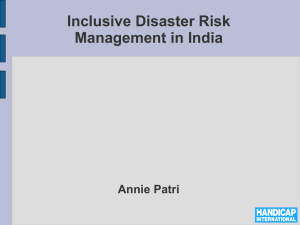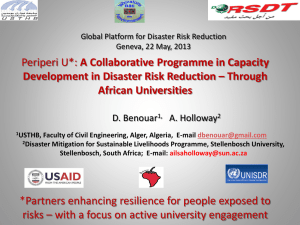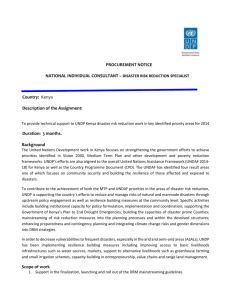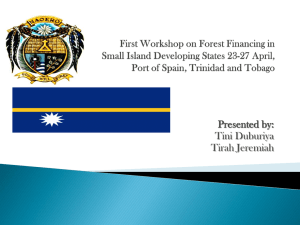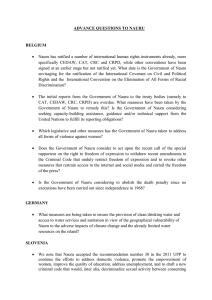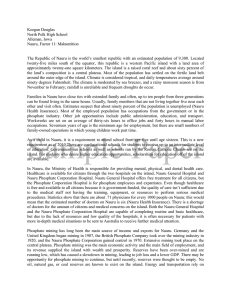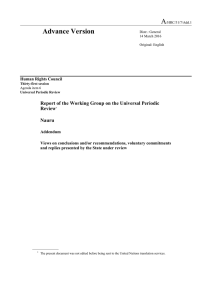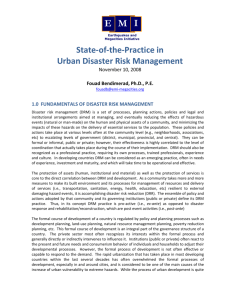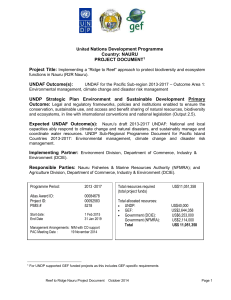Post-2015 consultation summary report - Nauru
advertisement
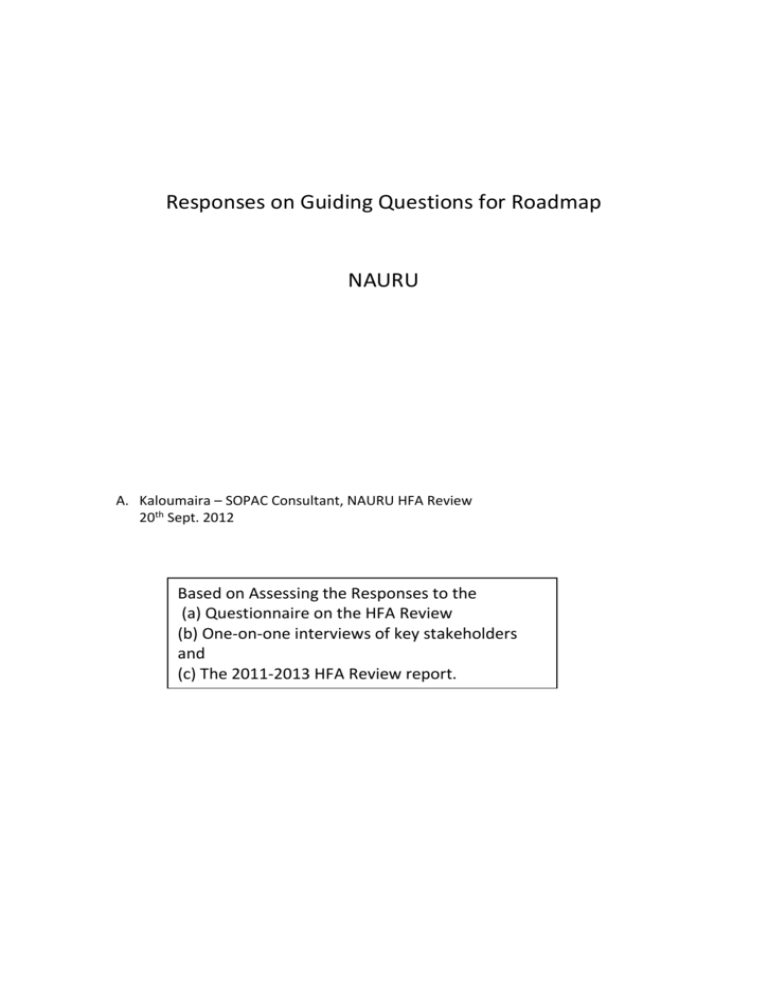
Responses on Guiding Questions for Roadmap NAURU A. Kaloumaira – SOPAC Consultant, NAURU HFA Review 20th Sept. 2012 Based on Assessing the Responses to the (a) Questionnaire on the HFA Review (b) One-on-one interviews of key stakeholders and (c) The 2011-2013 HFA Review report. SUMMARY 1.0 Current Level of CC and DRM Awareness and Understanding Not very comprehensive understanding though there is awareness. Nauru has low risks on natural hazards, vulnerable only to drought, stormy weather, surface ponding and coastal erosion. Awareness and understanding of Nauru’s management of DRM and CCA enhanced in the presentations on the respective institutional arrangements in the National Workshops. The RFA is not widely known with many having not heard of it. Academia and technical agencies fare better in understanding PIFACC, some are implementing NAPA Projects in the context of the PIFACC. 2.0 Achievements, Challenges and Opportunities Nauru’s National Disaster Risk Management Office is only 2-years in existence, hence the limit in the level of achievements, the most significant being o The political commitment to enact the National Disaster Risk Management Act, to establish the NDRM Office, and to develop a draft NDRM Plan. o The Act is all inclusive natural, environmental, technological and manmade hazards. o Coming through the economic crash has sensitised the population to hardship and disasters. There is no banking system; no insurance and local government was abolished. The HFA review has raised better understanding of DRM processes. o The history and future economic life of the phosphate resources are lessons in risk management, underpinning national policies and whole of country approach relating to sustainable development, environmental preservation and eco-system management. o The Nauru Sustainable Development Strategy is very user friendly and uses a coherent approach in addressing risk and sustainable development. It is well understood with programmes aligned with it. o Community Base Organisations (CBOs) are government appointed. A small number of ngo is present. Small businesses are organised under an Association but large businesses are not. o There is negligible representation of non-government sector in the national council and committees. o The participatory approach by NDRMO is enhancing multi-stakeholder engagement. o The increasing felt impacts of stormy weather at sea, changes in monsoon weather, ENSO events and sea level rises are sensitising the public to climate change issues. o The incorporation of DRM and CC into school curriculum is raising knowledge and understanding. o The increasing access of technical agencies and ngos to donor and IGO supported projects in sustainable management of natural resources and environmental issues, particularly community training and project funding and management. The major challenges for Nauru o To properly establish JNAP. o With projections of increasing severity of climate variabilities, the role of NDRMO as the subordinate Disaster Coordinator needs to be continually fortified. o More training on cross-cutting issues and how they factor in CCADRM are needed as there is need to strengthen understanding of the issues. o Coconut wireless is vibrant but awareness activities should be happening under a coherent countrywide awareness campaign strategy. o CCA-DRM Partnership with the community and with the academia should be strengthened in delivering CCA-DRM services into the community. o A big challenge is in modifying multi-hazard risk assessment information to incorporate cross cutting issues. Underlying Contributory Factors to the Challenges o The small scale in national CCA DRM institutional and human resources capacity and experiences is a limit vis-à-vis the pressures on national capacities from the diversity of CCADRM domain, driven by external funding facilities for “useful projects”. o Development growth is tied to the pace in rehabilitation of Nauru’s mined areas and credibility in the NSDS rests also with pace of implementing the NSDS. o Inability to provide a budget for NDRM Office and expand on the 1-person office is a significant constraint. o The NDRM Office is perhaps taking on an ambitious lead agency role with responsibility to entice Departments and agencies to incorporate DRR in Project planning without the requisite capacity. NDRM Office and National Planning need to review the lead agency role. o Cross cutting issues need to be campaigned and tutored appropriately into CCADRR sector policies. o CBOs are very proactive and their partnership with NGOs should be improved by strengthening the Nauru Island Association of NGOs to forge better coordination of programmes including transparent disclosures on usage of donated funds. Key Elements of Focus o Regional Strategy to Award Application of scientific and technical information for disaster risk management. There is a lot of scientifically researched reports on DRR available with SPC and SPREP but extent of application is little understood. o Regional Centre of Excellence for CCADRM and Mitigation To consolidate the regional approach to country specific applied researches in CCARM and mitigation. To develop a core of PICs national researchers on CCADRM To down scale researches and modelling to national and sub-national application. o Establish JNAP, its management structure complete with Activity and Work Plan Matrix o Strengthen Institutional capacities and networks on scientific hazard risk assessment, establish and upgrade disaster losses databases of key agencies o Develop minimum standards and guidelines on acceptable methodologies of DRR assessment inclusive of cost benefit analysis. o Mainstreaming gender, poverty and human rights issues in DRM Policies and Work Programmes o Review NSDS to fast track those activities addressing the reduction of underlying risks. Embed that DRR is structured in capital project planning and reporting systems and that DRR Cost-Benefit analysis is incorporated in project designs. o Develop CCADRM training strategies to include considerations for right skilling staff including those of CBOs and State Owned Enterprises to be DRM Training Instructors. Top Three Element to be addressed in the Post 2015 Regional Strategy o Development of Sectoral Policies in CCADRM with focus on reducing underlying risk factors o Funding and technical support on implementation of NSDS and JNAP. o Budget support for networking, technical upgrading and skilling of human resources for Institutional Strengthening 3.0 Disaster / Climate and Development Understanding of Disaster and Development o Nauru is the world’s smallest independent Republic, a phosphate rock island whose economy relies on phosphate reserves. It is by the equator with very little experiences of natural disasters apart from droughts and storms at sea. A statement on disaster/climate and development should be frame in the context that Nauru was reconstituting institutions from 2005 consequent to the economic collapse of the nation. The short term and long term goals of government were formulated in 2005 and expressed in the National Sustainable Development Strategy 2005-2025 (NSDS) aimed at lifting Nauru out of its long economic depression. o Today education and health policies, programmes and implementation capacities are strengthened. Literacy upgrading with continuing education are provided to uplift literacy level above 60%. Healthy-island living standards are surveyed and monitored aligned with strengthening of health early warning systems. Preventive health care programs improved and incidences of noncommunicable diseases monitored. Awareness to social vulnerabilities increased, data bases established, underlying socio-health risk factors reduced and community resilience to disaster risks strengthened. o Understanding of multi-hazard risk assessment should be initiated when JNAP is mainstreamed. Catastrophe risk financing explored as a regional initiative. Early warning system on tsunami developed and awareness raised with visits to schools. o The Water Sector is implementing integrated development of water sources which is mitigating water safety and security needs. Agriculture has started on food security programmes with development of nurseries. Utilities is focussing on achieving renewable energy targets set by the NSDS. 4. Accountability and Governance. o NDRMO in the Police Department is the lead agency responsible for RFA implementation; and for climate change the lead agency is the Climate Change Unit, CIE Ministry. The NDRMO is the Secretariat of the National Disaster Risk Management Council whilst the CC Unit is a new initiative. o Jurisdiction for monitoring the alignment of sector plans with the NSDS rests with the Finance and National Planning Office whilst sector priorities and mainstreaming of DRM rests within each Ministry. o There is no decentralised government administrative structure. The National Disaster Management Council has not been meeting regularly. o A DRM institutional design weakness is the absence of coherent DRR role for the National Planning Office. o Multi-sector membership of the national Council and sub-national committees is provisioned in the Act but is yet to be actioned. o The draft NDRM Plan should be reviewed with now a better understanding of CCA and DRM requirements. o Stringent reporting requirement to National Planning on incorporation of DRR considerations. 5. Linking DRM and Climate Change o Conclude establishment of JNAP and funding of Secretariat. o Land use policy Government major investment is tied to the rehabilitation strategy. Some good practices are the tuition of communities in ecosystem management, erosion reduction and environmentally friendly waste management systems. o EIA legislation has been drafted Cultural mapping has been undertaken Researched information provides threshold data for Design Floor Levels against storm surges, tsunamis. Drainage upgrading a concern due to flooding of low depressions, commercial entities and roadways. Utilities is to undertake a base line audit survey of facilities prior to upgrading of lifeline services. o There is no building code standards, however Ministry of Education ensures new buildings meet donors requirements on Building Codes standards. Safety of service fittings are more the concern as Nauru is not at risk to cyclones and not to earthquakes. Health is to build a new hospital and has incorporates DRR measures.
